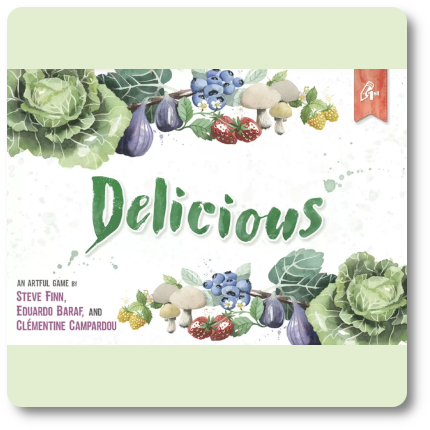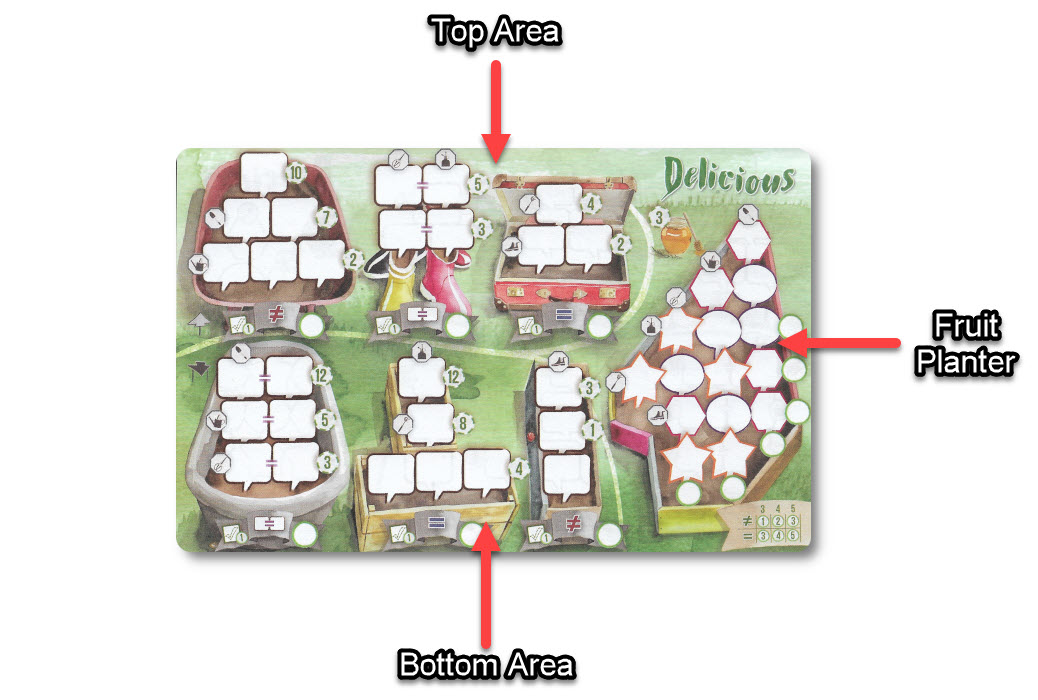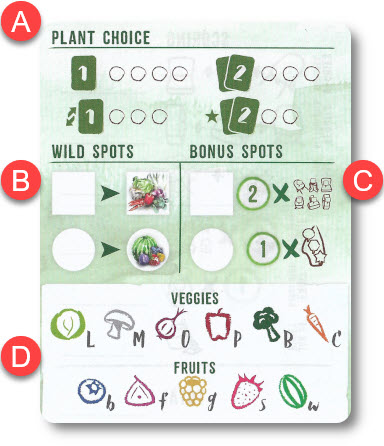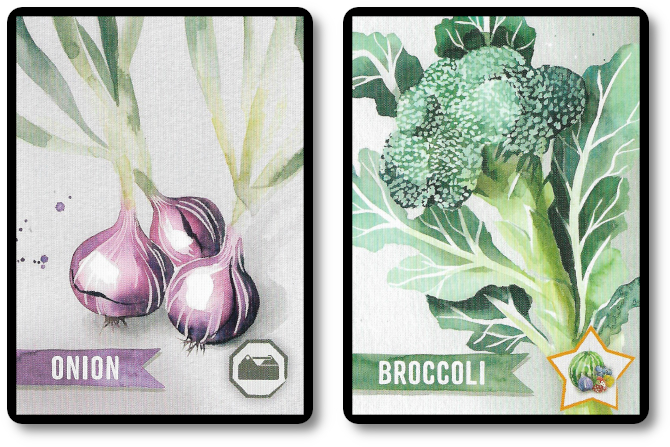 The Basics:
The Basics:
- For ages 14 and up
- For 1 to 100 players
- Approximately 30 minutes to complete
Geek Skills:
- Counting & Math
- Logical & Critical Decision Making
- Reading & Writing
- Pattern/Color Matching
- Strategy & Tactics
- Risk vs. Reward
- Visuospatial Skills
- Hand/Resource Management
Learning Curve:
- Child – Easy
- Adult – Easy
Theme & Narrative:
- Show everyone how strong your organizational and green thumbs skills are
Endorsements:
- Gamer Geek approved!
- Parent Geek approved!
- Child Geek mixed!
Overview
English architect, landscape architect, painter, and furniture designer of the early 18th century, William Kent, said “All gardening is landscape painting.” In this game, you creatively plant and organize several garden planters as you attempt to combine similar and dissimilar fruits and vegetables. This is a game that requires players to think less about strategy and more about tactical decisions at the moment. Taking risks, however, is all part of gardening and what makes it such a joy. Grab your gardening gloves and get ready to play in the dirt! It’s time to plant something delicious!
Delicious, designed by Eduardo Baraf, Steve Finn and published by Pencil First Games, is comprised of 30 Vegetable cards, 20 Fruit/Tool tokens, 100 Garden sheets (double-sided), 100 Play sheets (double-sided), two Top/Bottom Position markers, one Jar of Honey card, four pencils, one Crow token, and one cloth bag. All components in the game are thick and durable, presenting high quality right out of the box. Illustrations by Clémentine Campardou are bright and colorful, and further strengthen the game’s theme brilliantly.
Setting Up Your Garden
To set up the game, complete the following steps:
First, give each player one Garden sheet, one Play sheet, and a pencil. Any sheets and pencils not used are returned to the game box.
Second, shuffle the Vegetable cards and remove six at random, placing them back in the game box without revealing them to any player.
Third, separate the remaining Vegetable cards into two decks of 12 cards each. These decks are placed face-down in the middle of the playing area. This area is referred to as the “Community Supply”. Next to each deck, place either a Top Position marker or a Bottom Position marker. Leave room next to each deck for cards to be drawn and revealed during gameplay.
Fourth, place all the Fruit/Tool tokens in the bag and mix them up. Place the bag in the Community Supply area.
Fifth, place the Jar of Honey card off to one side in the Community Area. It will be awarded to a player later in the game. Keep it out so all may hungrily look at it.
Sixth, leave room in the Community Supply area for a discard pile which is referred to as the “Compost Pile.”
This completes the game setup! Enjoy your garden!
A Quick Tour of Your Garden
There are two game sheets used in Delicious. Both serve not only as a means to record points, but also as an empowering tool to plan, plant, and grow a garden. Each is summarized here.
The Garden Sheet
The Garden sheet represents the player’s garden in the game. Using this sheet, the players will be “planting” specific fruits and vegetables and rows and columns in their garden.

The Play Sheet
The Play sheet keeps track of how the player is able to plant fruits and vegetables in their Garden sheet.

A: Plant Choice
There are four choices available to the player. All choices are available to the players at the start of the game but decrease in their availability as the game progresses. They are as follows:
- One Card (as is): Use one card in its current position
- Two Cards (as is): Use two cards in their current position
- One Card (reverse): Use one card, but reverse its position (top is now bottom, bottom is now top)
- Two Cards (reverse): Use both cards, reversing their position
“Position” in this case means top or bottom and identifies where in your garden you can plant it.
B: Wild Spots
A player may record any one fruit and any one vegetable to change it to any other fruit or vegetable. This can only be done once per game for both the fruit and the vegetable.
C: Bonus Spots
A player may record any one fruit and any vegetable to receive additional bonus points at the end of the game for the number of the type indicated.
D: Veggies and Fruits
A handy guide for the player to record the vegetable or fruit by either illustrating the consumable or using a single letter to represent what it is. I am of the personal opinion that you should always use the letters for a faster game, but you do you.
On the opposite side of the sheet is a guide to score, which we will discuss later in this review.
Let’s Get Planting!
Delicious is played in rounds for a total of 12 rounds per game. All players take action simultaneously during each round. A game round is summarized here.
Step 1: Reveal Cards and Tools
Any player flips over the top-most cards from the two Vegetable draw decks in the Community Supply. Then they draw two Fruit/Tool tokens from the bag, placing one token on each of the cards. Note that the Fruit/Tool tokens are double-sided. The side to be placed on the card is noted on the Vegetable card. It will always be a Fruit or a Tool, but never both.

Step 2: Choose and Sketch/Record Plants
All players now decide what they want to do with the visible cards. The actions available to them are listed on the Play sheet. When they select the action, they mark it off, indicating what action they took. They can only take that action if it is available to them.
After selecting the card or cards and keeping the card’s position, or not, the player updates their Garden sheet. Players may do so by either drawing the vegetable or fruit or using a single letter as shorthand. In either case, both the vegetable listed on the card and the Fruit/Tool are used. However, it might not be possible to do so based on space availability in the garden.
There are a total of six different vegetable types. This vegetable can be put in any of the available spots based on the player’s Garden sheet and the card’s position (top or bottom row). Optionally, the player can add it to their “Wild” or “Bonus” space on the Play sheet.
The containers can contain a combination of similar vegetables, different vegetables, or pairs of vegetables. Players must plant their vegetables according to these rules. In addition, they must always plant from the bottom and then go up, only able to move to the next row when the row below it is completely filled.
The containers for fruit and tools operate differently. A Fruit can only be added to a space that matches the shape (oval, star, or hexagon). Tool tokens allow the player to add any one vegetable or fruit in accordance with the placement rules, but only in that space indicated by a matching tool symbol.
Step 3: Ending the Round
After the players have filled in their Garden and Play sheet where applicable, the round comes to an end. The visible face-up Vegetable cards and attached tokens are placed in a discard pile referred to as the “Compost Pile.”
All players now check to see if any bonuses are awarded.
- The “First Potter Bonus” is awarded to any player who was the first to completely fill a vegetable container. This player earns a bonus point, while all other players indicate on their sheet that it is no longer available. More than one player can earn this bonus during the same round.
- The “Jar of Honey” bonus card is awarded to the first player to completely fill their vegetable containers on either the top or bottom areas of their Garden sheet. This card is given to the player to place in front of them until the end of the game. More than one player can earn this bonus during the same round.
If this was the 12th and final round, continue to end-of-game scoring. Otherwise, start a new round with step one noted above.
Reaping What You Sow
Scores are calculated for the different areas of the game, including the fruit planter. The reverse side of the Play sheet has a handy scoring pad to assist.

After all the points are calculated, the player with the most points wins the game.
To learn more about Delicious, visit the game’s webpage.
Final Word
 The Child Geeks had no problem learning how to play Delicious, as the rules and gameplay are very straightforward. They particularly liked that none of the other players could “mess with their garden” and they were given freedom to plant where they thought best. This freedom, however, also turned out to be the biggest headache for the youngest of our players. According to one Child Geek, “I get confused sometimes where I can and cannot plant. There is always someone to help me, but I found it frustrating at times that I couldn’t plant what I needed.” Another Child Geek said, “I liked the game and it took me one full game before I really enjoyed and knew how to play. You have to be careful about what you plant and where. You need to be a really good gardener, but not in real life. Just in the game.” When all the seeds were planted, the Child Geeks took a vote and gave Delicious a mixed endorsement. Turns out the game was just a bit too abstract in the gameplay and a bit too concrete in the rules to mix well for their young minds.
The Child Geeks had no problem learning how to play Delicious, as the rules and gameplay are very straightforward. They particularly liked that none of the other players could “mess with their garden” and they were given freedom to plant where they thought best. This freedom, however, also turned out to be the biggest headache for the youngest of our players. According to one Child Geek, “I get confused sometimes where I can and cannot plant. There is always someone to help me, but I found it frustrating at times that I couldn’t plant what I needed.” Another Child Geek said, “I liked the game and it took me one full game before I really enjoyed and knew how to play. You have to be careful about what you plant and where. You need to be a really good gardener, but not in real life. Just in the game.” When all the seeds were planted, the Child Geeks took a vote and gave Delicious a mixed endorsement. Turns out the game was just a bit too abstract in the gameplay and a bit too concrete in the rules to mix well for their young minds.
 The Parent Geeks, on the other hand, had a really great time with the game, finding the gameplay to be casual and engaging, not to mention challenging. As one Parent Geek put it, “This game is deceptively simple and it becomes increasingly difficult as you progress. All the values you need are randomly generated and you must make the best choice you can given what you have. But, you also get to shift the cards around, but even that is limited. It really made me think and I really enjoyed myself.” Another Parent Geek agreed and added, “What made this game for me really fun was that it was essentially a solitaire experience but with friends and family. It was very casual, we were able to visit and laugh while at the same time playing a very engaging game. Great stuff.” When the little plants started to grow and the garden began to fill out, the Parent Geeks all agreed that this was a game that really grew on them.
The Parent Geeks, on the other hand, had a really great time with the game, finding the gameplay to be casual and engaging, not to mention challenging. As one Parent Geek put it, “This game is deceptively simple and it becomes increasingly difficult as you progress. All the values you need are randomly generated and you must make the best choice you can given what you have. But, you also get to shift the cards around, but even that is limited. It really made me think and I really enjoyed myself.” Another Parent Geek agreed and added, “What made this game for me really fun was that it was essentially a solitaire experience but with friends and family. It was very casual, we were able to visit and laugh while at the same time playing a very engaging game. Great stuff.” When the little plants started to grow and the garden began to fill out, the Parent Geeks all agreed that this was a game that really grew on them.
 The Gamer Geeks found Delicious to be very casual – much like the Parent Geeks – and challenging. Challenging enough to make them lean forward and take notice. Where they thought the game would be easy, it turned out to be a surprising level of difficulty. It wasn’t perfect by any means, in fact, they shared a small number of negative points – but the overall experience was found to be very pleasant. As one Gamer Geek reported, “Pencil First Games is well known for releasing interesting games that elicit moments of calm while still challenging players to think hard. I found this game to be no different. Although, I do think they are doubling down a bit too much on the whole plants and garden motif. Still, I found this to be a fun game. Great for a filler in my opinion.” Another Gamer Geek said, “It’s a game of solitary decision-making that either pays off at the end or doesn’t. I wouldn’t think much of the game if it weren’t for the nail-biting scoring at the end and seeing how badly you won or lost. I would play this game as a filler or with other players who were not up to the same type of games I normally enjoy. There’s more than enough here to keep me interested.” When all the vegetables and fruits were harvested, the Gamer Geeks found that Delicious was a tasty treat.
The Gamer Geeks found Delicious to be very casual – much like the Parent Geeks – and challenging. Challenging enough to make them lean forward and take notice. Where they thought the game would be easy, it turned out to be a surprising level of difficulty. It wasn’t perfect by any means, in fact, they shared a small number of negative points – but the overall experience was found to be very pleasant. As one Gamer Geek reported, “Pencil First Games is well known for releasing interesting games that elicit moments of calm while still challenging players to think hard. I found this game to be no different. Although, I do think they are doubling down a bit too much on the whole plants and garden motif. Still, I found this to be a fun game. Great for a filler in my opinion.” Another Gamer Geek said, “It’s a game of solitary decision-making that either pays off at the end or doesn’t. I wouldn’t think much of the game if it weren’t for the nail-biting scoring at the end and seeing how badly you won or lost. I would play this game as a filler or with other players who were not up to the same type of games I normally enjoy. There’s more than enough here to keep me interested.” When all the vegetables and fruits were harvested, the Gamer Geeks found that Delicious was a tasty treat.
 I am on record stating multiple times how much I enjoy Pencil First Games. They are always charming, and beautiful to look at, remind me of simpler times, and relax me. They are also challenging and engaging. Delicious is just one more game in a long line of games from this publisher that has filled me with joy. Delicious combines the right amount of thinking with the casual gameplay you’d expect. Games start out easy – breezy even – with each round presenting the player with new choices to make with an ever-dwindling ability to maneuver. This created a growing sense of urgency and focus. By the time the game ended after 12 rounds, I felt like I had just climbed a large number of stairs, mentally speaking.
I am on record stating multiple times how much I enjoy Pencil First Games. They are always charming, and beautiful to look at, remind me of simpler times, and relax me. They are also challenging and engaging. Delicious is just one more game in a long line of games from this publisher that has filled me with joy. Delicious combines the right amount of thinking with the casual gameplay you’d expect. Games start out easy – breezy even – with each round presenting the player with new choices to make with an ever-dwindling ability to maneuver. This created a growing sense of urgency and focus. By the time the game ended after 12 rounds, I felt like I had just climbed a large number of stairs, mentally speaking.
A quick word on the player count. Yes, you really can play this game with 100 people. Probably even more. Since all the rounds are done with the players simultaneously taking their turns and all using the same cards, there is nothing stopping you from playing this game with any number of people. The only thing that will limit you is space and sheets to record your game’s progress.
Great stuff.
Do try Delicious when the opportunity presents itself. This game will challenge you to think ahead, plan your space, and be ready to take advantage of unexpected opportunities. Plant this on your family gaming table to see if it grows on all who are fortunate enough to bite into it.
This game was given to Father Geek as a review copy. Father Geek was not paid, bribed, wined, dined, or threatened in vain hopes of influencing this review. Such is the statuesque and legendary integrity of Father Geek.



